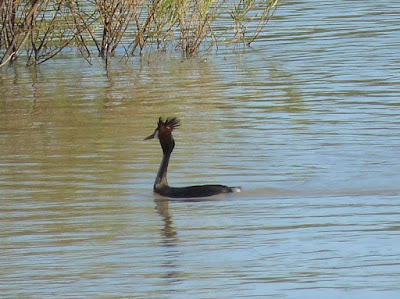A little while ago we'd been gaping at some particularly impressive bird head adornments, and my muse said "well, why not do a blog on them?". Why not indeed? I do quite a lot of more 'serious' postings, and it doesn't hurt sometimes to just enjoy aspects of this wonderful natural world. Besides, I don't seem to have quite the readership I once did (I'm referring solely to quantity of course, not quality!) and who knows, maybe some fancy feather-styles are just what this blog needs!
According to my count there are some 135 bird species with 'crested' in the name; I was about to check those with 'cristatus' (ie 'crested') in the scientific name, but just in time I recalled how fleeting life really is. Today I'm going to limit myself to birds whose names either contain 'crested' or another reference to their headware.
 |
| Rufous-crested Coquette Lophornis delattrei, Waqanki Lodge, northern Peru. Extraordinary. This hummingbird is mostly an Andean species, with a lowland outlier population in Panama. |
Many such adornments are male-specific, and it is generally assumed that they're all about display, the idea being that the bigger and gaudier the display, the more attracted a female will be. Maybe, but we should always ask 'why?' and also remember that there's often more than one answer. This post isn't supposed to be too serious, but a couple of points are still worth making. If she's making a mate choice based purely on what are essentially male-only aesthetics, then we can assume that her sons will also be similarly gorgeous and desirable - but what about her daughters? In such a situation I think it is more that he is effectively saying ‘look, I’m so strong and clever and have such great survival skills that I can afford to carry around this idiotic frippery – even though it makes me more of a target for predators – and those are the characteristics you want for your chicks, sons and daughters’. We can see this taken to extremes with the peacock’s tail, the Irish Elk’s antlers, and the ludicrous wing appendages of some bowerbirds, nightjars and birds of paradise. Most cresties don't go nearly this far however, most of them sporting a more modest crest that can be demurely tucked away and produced on demand.
 |
| Another hummingbird, the Wire-crested Thorntail Discosura popelairii, north-eastern Peruvian Andes. As with the coquette above, this crest is strictly for boys only. |
In many crested birds however the female does also has a crest, though often more modest. Perhaps this is a genetic legacy, or perhaps each of the pair (or prospective pair) uses the quality of its mate's crest as a gauge of the other's overall fitness.
In Sulphur-crested Cockatoos, all adults are equally well-endowed and seem to flare the crest in communication, perhaps a warning, often in association with an ear-assaulting shriek.
 |
| Sulphur-crested Cockatoo Cacatua galerita, Nowra, New South Wales. |
Both sexes of a couple of Australian seed-eating pigeons also have identical crests, and I wonder if here they have a role in allowing members of the flock to keep an eye on their colleagues while all are feeding head-down among the grass clumps.
Here are some more birds whose names specify that they have a crest. As you'll see the prominence of their crests varies greatly.
 |
| Crested Coua Coua cristata, Ankarana NP, Madagascar. The couas are a group of cuckoos endemic to Madagascar. |
 |
| Pale-crested Woodpecker Celeus lugubris, Pantanal, south-west Brazil. |
 |
| Plush-crested Jay Cyanocorax chrysops, Iguazu Falls, northern Argentina (the falls are also in Brazil, but this jay wasn't). A fabulous jay, found across central South America east of the Andes. |
 |
| Crested Oropendola Psarocolius decumanus, Pantanal, Brazil. You can just see the wispy crest lying along its neck. |
 |
| Crested Shrike-tit Falcunculus frontatus, Forbes, New South Wales. To be fair, this strong-billed little bird can erect its crest to be slightly more conspicuous than this photo suggests. |
 |
| White-tufted Grebe Rollandia rolland, Torres del Paine NP, Chilean Patagonia. Both male and female put on the dramatic pied crest only for breeding season. |
 |
| Black Crowned Crane, Waza NP, northern Cameroon. |
 |
| Great Horned Owl Bubo virginianus, El Cajas NP, high in the Andes of southern Ecuador. A huge owl, also found across most of North America. |
And that brings us to an end for today, hopefully leaving you satisfied and sated with crests for now. Not permanently though I trust, as I'll be back next time to finish this exploration of fabulous bird head adornments, looking at a collection of great crests which failed to grab the attention of those naming them.
NEXT POSTING THURSDAY 29 NOVEMBER
(And
remember that you can get a reminder when the next post appears by
putting your email address in the Follow by Email box in the top right
of this screen.
And I'd love to receive your comments - it's easy and you don't need to sign in!)
And I'd love to receive your comments - it's easy and you don't need to sign in!)













No comments:
Post a Comment